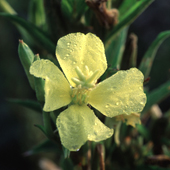Back to: Health Information : Health Topics A–Z

Evening Primrose Oil
Keywords: eczema, rheumatoid arthritis, breast pain, menopausal symptoms

© Steven Foster
On this page
- Introduction
- What It Is Used For
- How It Is Used
- What the Science Says
- Side Effects and Cautions
- Sources
- For More Information
Introduction
This fact sheet provides basic information about evening primrose oil—common names, uses, potential side effects, and resources for more information. Evening primrose is a plant native to North America, but it grows in Europe and parts of the Southern Hemisphere as well. It has yellow flowers that bloom in the evening. Evening primrose oil contains gamma-linolenic acid (GLA), an essential fatty acid. Essential fatty acids are required by the body for growth and development, and must be obtained from the diet.
Common Names—evening primrose oil, EPO
Latin Name—Oenothera biennis
What It Is Used For
- Evening primrose oil has been used since the 1930s for eczema (a condition in which the skin becomes inflamed, itchy, or scaly because of allergies or other irritation).
- More recently it has been used for other conditions involving inflammation, such as rheumatoid arthritis.
- Evening primrose oil is used for conditions affecting women's health, such as breast pain associated with the menstrual cycle, menopausal symptoms, and premenstrual syndrome.
- Other conditions for which evening primrose oil is used include cancer and diabetes.
How It Is Used
Evening primrose oil is extracted from the seeds of the evening primrose. The oil is usually put into capsules for use.
What the Science Says
- Evening primrose oil may have modest benefits for eczema, and it may be useful for rheumatoid arthritis and breast pain. However, study results are mixed, and most studies have been small and not well designed.
- Evening primrose oil does not appear to affect menopausal symptoms.
- Although some clinical trials have shown a benefit of evening primrose oil for premenstrual syndrome, the best-designed trials found no effect.
- There is not enough evidence to support the use of evening primrose oil for other health conditions.
Side Effects and Cautions
- Evening primrose oil is well tolerated by most people. Mild side effects include gastrointestinal upset and headache.
- Tell your health care providers about any complementary and alternative practices you use. Give them a full picture of what you do to manage your health. This will help ensure coordinated and safe care.
Sources
- Shahidi F, Miraliakbari H. Evening primrose (Oenothera biennis). In: Coates P, Blackman M, Cragg G, et al., eds. Encyclopedia of Dietary Supplements. New York, NY: Marcel Dekker; 2005:197–210.
- Evening primrose oil. Natural Medicines Comprehensive Database Web site. Accessed on July 6, 2007.
- Evening primrose oil (Oenothera biennis L.). Natural Standard Web site. Accessed on July 3, 2007.
For More Information
- What's in the Bottle? An Introduction to Dietary Supplements
- Herbal Supplements: Consider Safety, Too
NCCAM Clearinghouse
Toll-free in the U.S.: 1-888-644-6226
TTY (for deaf and hard-of-hearing callers): 1-866-464-3615
E-mail: info@nccam.nih.gov
CAM on PubMed
Web site: nccam.nih.gov/camonpubmed/
NIH Office of Dietary Supplements
Web site: ods.od.nih.gov
NIH National Library of Medicine's MedlinePlus
Evening Primrose Oil Listing: www.nlm.nih.gov/medlineplus/druginfo/natural/patient-primrose.html
This publication is not copyrighted and is in the public domain. Duplication is encouraged.
NCCAM has provided this material for your information. It is not intended to substitute for the medical expertise and advice of your primary health care provider. We encourage you to discuss any decisions about treatment or care with your health care provider. The mention of any product, service, or therapy is not an endorsement by NCCAM. |
NCCAM Publication No. D341
Created December 2006
Updated March 2008
Note: The PDF file requires a viewer such as Adobe Reader, which you can download free of charge from the Adobe Web site.
